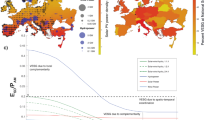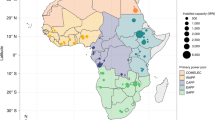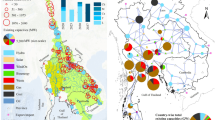Abstract
The worldwide growth of variable renewable power sources necessitates power system flexibility to safeguard the reliability of electricity supply. Yet today, flexibility is mostly delivered by fossil fuel power plants. Hydropower can be a renewable alternative source of flexibility, but only if operated according to adequate strategies considering hourly-to-decadal and local-to-regional energy and water needs. Here, we present a new model to investigate hydro–solar–wind complementarities across these scales. We demonstrate that smart management of present and future hydropower plants in West Africa can support substantial grid integration of solar and wind power, limiting natural gas consumption while avoiding ecologically harmful hydropower overexploitation. We show that pooling regional resources and planning transmission grid expansion according to spatiotemporal hydro–solar–wind synergies are crucial for optimally exploiting West Africa’s renewable potential. By 2030, renewable electricity in such a regional power pool, with solar and wind contributing about 50%, could be at least 10% cheaper than electricity from natural gas.
This is a preview of subscription content, access via your institution
Access options
Access Nature and 54 other Nature Portfolio journals
Get Nature+, our best-value online-access subscription
$29.99 / 30 days
cancel any time
Subscribe to this journal
Receive 12 digital issues and online access to articles
$119.00 per year
only $9.92 per issue
Buy this article
- Purchase on Springer Link
- Instant access to full article PDF
Prices may be subject to local taxes which are calculated during checkout






Similar content being viewed by others
Data availability
The ERA5 reanalysis data were downloaded from the Climate Data Store at https://cds.climate.copernicus.eu/. The data from CORDEX-Africa framework are available at http://cordex.org/data-access/esgf. EWEMBI forcing data can be accessed at https://doi.org/10.5880/pik.2019.004. Shapefiles for rivers and climate zones, used in Fig. 3, are available in the ECOWREX database60 at http://www.ecowrex.org/mapView/. Country border shapefiles, used in Figs. 3 and 6, are available in the GADM database73 at https://gadm.org/maps.html. The maps in Figs. 3 and 6 were created using QGIS74, which can be downloaded from http://qgis.osgeo.org/. Grid load data from Ghana are available at http://ghanagrid.com/index.php/loadprofile. Grid load data from Burkina Faso are available upon request, as are the data on the LCOE of existing and future hydropower plants in West Africa. LCOE data for solar and wind power in West Africa are available in the IRENA report referenced in Supplementary Note 9.4. The SWAT+ simulation results are available from Zenodo75. All other plant-level data used in the simulations are available and fully referenced in the WARPD database, provided as Supplementary Data to this paper. The data points behind the data plotted in the Figures can be found in Figshare76.
Code availability
The REVUB model code (version 0.1.0) is available at https://github.com/VUB-HYDR/REVUB under the MIT license, for Python as well as MATLAB. Datasets to run a minimal working example are available in the same repository.
References
Renewable Power Generation Costs in 2018 (International Renewable Energy Agency, 2019); https://go.nature.com/2LkmxWw
Engeland, K. et al. Space-time variability of climate variables and intermittent renewable electricity production – a review. Renew. Sustain. Energy Rev. 79, 600–617 (2017).
Welsch, M. et al. Incorporating flexibility requirements into long-term energy system models – a case study on high levels of renewable electricity penetration in Ireland. Appl. Energy 135, 600–615 (2014).
Poncelet, K., Delarue, E., Six, D., Duerinck, J. & D’haeseleer, W. Impact of the level of temporal and operational detail in energy-system planning models. Appl. Energy 162, 631–643 (2016).
Kozarcanin, S., Liu, H. & Andresen, G. B. 21st century climate change impacts on key properties of a large-scale renewable-based electricity system. Joule 3, 992–1005 (2019).
Zeyringer, M., Price, J., Fais, B., Li, P.-H. & Sharp, E. Designing low-carbon power systems for Great Britain in 2050 that are robust to the spatiotemporal and inter-annual variability of weather. Nat. Energy 3, 395–403 (2018).
Sterl, S., Liersch, S., Koch, H., van Lipzig, N. P. & Thiery, W. A new approach for assessing synergies of solar and wind power: implications for West Africa. Environ. Res. Lett. 13, 094009 (2018).
Power System Flexibility for the Energy Transition, Part 1: Overview for Policy Makers (International Renewable Energy Agency, 2018); https://go.nature.com/2LktXc4
Planning for the Renewable Future: Long-Term Modelling and Tools to Expand Variable Renewable Power in Emerging Economies (International Renewable Energy Agency, 2017); https://go.nature.com/2SVfkAd
Gonzalez-Salazar, M. A., Kirsten, T. & Prchlik, L. Review of the operational flexibility and emissions of gas- and coal-fired power plants in a future with growing renewables. Renew. Sustain. Energy Rev. 82, 1497–1513 (2018).
Kuramochi, T. et al. Ten key short-term sectoral benchmarks to limit warming to 1.5∘C. Clim. Policy 18, 287–305 (2018).
Hirth, L. The benefits of flexibility: the value of wind energy with hydropower. Appl. Energy 181, 210–223 (2016).
Olauson, J. et al. Net load variability in Nordic countries with a highly or fully renewable power system. Nat. Energy 1, 16175 (2016).
Mitchell, C. Momentum is increasing towards a flexible electricity system based on renewables. Nat. Energy 1, 15030 (2016).
Gernaat, D. E. H. J., Bogaart, P. W., van Vuuren, D. P., Biemans, H. & Niessink, R. High-resolution assessment of global technical and economic hydropower potential. Nat. Energy 2, 821–828 (2017).
Waldman, J., Sharma, S., Afshari, S. & Fekete, B. Solar-power replacement as a solution for hydropower foregone in US dam removals. Nat. Sustain. 2, 872–878 (2019).
Hart, E. K. & Jacobson, M. Z. A Monte Carlo approach to generator portfolio planning and carbon emissions assessments of systems with large penetrations of variable renewables. Renew. Energy 36, 2278–2286 (2011).
Jacobson, M. Z., Delucchi, M. A., Cameron, M. A. & Frew, B. A. Low-cost solution to the grid reliability problem with 100% penetration of intermittent wind, water, and solar for all purposes. Proc. Natl Acad. Sci. USA 112, 15060–15065 (2015).
Zarfl, C., Lumsdon, A. E., Berlekamp, J., Tydecks, L. & Tockner, K. A global boom in hydropower dam construction. Aquat. Sci. 77, 161–170 (2015).
Falchetta, G., Gernaat, D. E., Hunt, J. & Sterl, S. Hydropower dependency and climate change in sub-Saharan Africa: a nexus framework and evidence-based review. J. Clean. Prod. 231, 1399–1417 (2019).
Conway, D., Dalin, C., Landman, W. A. & Osborn, T. J. Hydropower plans in eastern and southern Africa increase risk of concurrent climate-related electricity supply disruption. Nat. Energy 2, 946–953 (2017).
Schmitt, R. J. P., Kittner, N., Kondolf, G. M. & Kammen, D. M. Deploy diverse renewables to save tropical rivers. Nature 569, 330–332 (2019).
Wang, X., Mei, Y., Kong, Y., Lin, Y. & Wang, H. Improved multi-objective model and analysis of the coordinated operation of a hydro-wind-photovoltaic system. Energy 134, 813–839 (2017).
Yang, Z. et al. Deriving operating rules for a large-scale hydro-photovoltaic power system using implicit stochastic optimization. J. Clean. Prod. 195, 562–572 (2018).
Wang, X., Chang, J., Meng, X. & Wang, Y. Short-term hydro-thermal-wind-photovoltaic complementary operation of interconnected power systems. Appl. Energy 229, 945–962 (2018).
Ming, B., Liu, P., Guo, S., Cheng, L. & Zhang, J. Hydropower reservoir reoperation to adapt to large-scale photovoltaic power generation. Energy 179, 268–279 (2019).
Kern, J. D., Patino-Echeverri, D. & Characklis, G. W. An integrated reservoir-power system model for evaluating the impacts of wind integration on hydropower resources. Renew. Energy 71, 553–562 (2014).
François, B., Hingray, B., Raynaud, D., Borga, M. & Creutin, J. Increasing climate-related-energy penetration by integrating run-of-the river hydropower to wind/solar mix. Renew. Energy 87, 686–696 (2016).
Gebretsadik, Y., Fant, C., Strzepek, K. & Arndt, C. Optimized reservoir operation model of regional wind and hydro power integration case study: Zambezi basin and South Africa. Appl. Energy 161, 574–582 (2016).
Planning and Prospects for Renewable Power: West Africa (International Renewable Energy Agency, 2018); https://go.nature.com/2zuEuPe
ECOWAS Master Plan for the Development of Regional Power Generation and Transmission Infrastructure 2019-2033. Final Report Volume 0: Synthesis (Tractebel Engineering, 2018); https://go.nature.com/3cos9Lh
ECREEE. Country documents. ECOWAS SE4All Network https://go.nature.com/2xSB0Wz (2015).
Oyewo, A. S., Farfan, J., Peltoniemi, P. & Breyer, C. Repercussion of large scale hydro dam deployment: the case of Congo Grand Inga hydro project. Energies 11, 972 (2018).
Cole, M. A., Elliott, R. J. & Strobl, E. Climate change, hydro-dependency, and the African dam boom. World Dev. 60, 84–98 (2014).
Bogdanov, D. et al. Radical transformation pathway towards sustainable electricity via evolutionary steps. Nat. Commun. 10, 1077 (2017).
Barasa, M., Bogdanov, D., Oyewo, A. S. & Breyer, C. A cost optimal resolution for Sub-Saharan Africa powered by 100% renewables in 2030. Renew. Sustain. Energy Rev. 92, 440–457 (2018).
Jacobson, M. Z., Delucchi, M. A., Cameron, M. A. & Mathiesen, B. V. Matching demand with supply at low cost in 139 countries among 20 world regions with 100% intermittent wind, water, and sunlight (WWS) for all purposes. Renew. Energy 123, 236–248 (2018).
Jägermeyr, J., Pastor, A., Biemans, H. & Gerten, D. Reconciling irrigated food production with environmental flows for sustainable development goals implementation. Nat. Commun. 8, 15900 (2017).
Perez, M., Perez, R., Rábago, K. R. & Putnam, M. Overbuilding and curtailment: the cost-effective enablers of firm PV generation. Sol. Energy 180, 412–422 (2019).
Stanzel, P., Kling, H. & Bauer, H. Climate change impact on West African rivers under an ensemble of CORDEX climate projections. Clim. Serv. 11, 36–48 (2018).
Moran, E. F., Lopez, M. C., Moore, N., Müller, N. & Hyndman, D. W. Sustainable hydropower in the 21st century. Proc. Natl Acad. Sci. USA 115, 11891–11898 (2018).
Adeoye, O. & Spataru, C. Sustainable development of the West African power pool: increasing solar energy integration and regional electricity trade. Energy Sustain. Dev. 45, 124–134 (2018).
Russo, D. & Miketa, A. Benefits, challenges, and analytical approaches to scaling up renewables through regional planning and coordination of power systems in Africa. Curr. Sustain. Renew. Energy Rep. 6, 5–12 (2019).
Yang, W. et al. Burden on hydropower units for short-term balancing of renewable power systems. Nat. Commun. 9, 2633 (2018).
Zhang, M. et al. Dynamic model and impact on power quality of large hydro-photovoltaic power complementary plant. Int. J. Energy Res. 43, 4436–4448 (2019).
Mentis, D., Hermann, S., Howells, M., Welsch, M. & Siyal, S. H. Assessing the technical wind energy potential in Africa: a GIS-based approach. Renew. Energy 83, 110–125 (2015).
Spyrou, E., Hobbs, B. F., Bazilian, M. D. & Chattopadhyay, D. Planning power systems in fragile and conflict-affected states. Nat. Energy 4, 300–310 (2019).
Innovation Landscape for a Renewable-Powered Future: Solutions to Integrate Variable Renewables (International Renewable Energy Agency, 2019); https://go.nature.com/2STLuvQ
Mathiesen, B. et al. Smart energy systems for coherent 100% renewable energy and transport solutions. Appl. Energy 145, 139–154 (2015).
The Ghana Renewable Energy Master Plan (Energy Commission, accessed 14 February 2019); https://go.nature.com/2WN6PIu
Ceesay, K. K. Sustainable Energy Action Plan for The Gambia (ECREEE & SE4All, 2015); https://go.nature.com/3drKdUS
Plano de Investimento Para Energia Sustentável da Guiné-Bissau (UNIDO, GEF & ECREEE, 2017); https://go.nature.com/3cpwJc3
Evaluation et Analyse des Gaps par Rapport aux Objectifs de SE4All - République de Guinée (UNDP & SE4All, 2014); https://go.nature.com/2WjApXb
République du Niger. Contribution Prévue Déterminée au Niveau National - CPDN (INDC) du Niger (UNFCCC, 2015); https://go.nature.com/2WnaWfF
Previsic, M. et al. The Future Potential of Wave Power in the United States (US Department of Energy, RE Vision Consulting, 2012); https://go.nature.com/3bqVGlX
Oyerinde, G. T. et al. Quantifying uncertainties in modeling climate change impacts on hydropower production. Climate 4, 34 (2016).
ECOWAS Renewable Energy Policy (ECREEE, 2015); https://go.nature.com/2yBU0ZS
Kappiah, M. et al. Baseline Report on Existing and Potential Small-Scale Hydropower Systems in the ECOWAS Region (ECREEE, 2012); https://go.nature.com/3blNtzy
GIS Hydropower Resource Mapping and Climate Change Scenarios for the ECOWAS Region - Technical Report on Methodology and Lessons Learnt for ECOWAS Countries (ECREEE, 2017). https://go.nature.com/2WJNmZn
ECOWREX. Map Viewer http://www.ecowrex.org/mapView/index.php?lang=eng (2018).
ECOWREX. Projects http://www.ecowrex.org/resources/projects (2018).
Liersch, S. et al. Water resources planning in the Upper Niger River basin: are there gaps between water demand and supply? J. Hydrol. Reg. Stud. 21, 176–194 (2019).
Bieger, K. et al. Introduction to SWAT+, a completely restructured version of the Soil and Water Assessment Tool. J. Am. Water Resour. Assoc. 53, 115–130 (2017).
Farr, T. G. et al. The shuttle radar topography mission. Rev. Geophys. 45, 183 (2007).
Hurtt, G. C. et al. Harmonization of land-use scenarios for the period 1500–2100: 600 years of global gridded annual land-use transitions, wood harvest, and resulting secondary lands. Clim. Change 109, 117 (2011).
Leenaars, J. Africa Soil Profiles Database (Version 1.1): A Compilation of Georeferenced and Standardised Legacy Soil Profile Data for Sub-Saharan Africa (With Dataset) (Africa Soil Information Service, ISRIC - World Soil Information, 2013).
Lange, S. EartH2Observe, WFDEI and ERA-Interim Data Merged and Bias-Corrected for ISIMIP (EWEMBI) (GFZ Data Services, 2016); https://go.nature.com/3fAN2Vn
Vanderkelen, I., van Lipzig, N. P. M. & Thiery, W. Modelling the water balance of Lake Victoria (East Africa) – part 1: observational analysis. Hydrol. Earth Syst. Sci. 22, 5509–5525 (2018).
Ndiaye, A. Long Term Evolution of Temperature and Heat Waves and Impact on Electricity Consumption over West African Cities: Comparative Study Between Dakar (West Coast) and Niamey (Central Sahel). MSc thesis, Univ. Abdou Moumouni (2015); http://wascal-ne.org/aissatou.html
Kouadio, N. A. E. J. Impact of Climate Change on Electricity Consumption in West Africa (A Case Study of Côte d’Ivoire). MSc thesis, Univ. Abdou Moumouni (2018); http://wascal-ne.org/kouadio.html
Ta, S. et al. West Africa extreme rainfall events and large-scale ocean surface and atmospheric conditions in the tropical atlantic. Adv. Meteorol. 2016, 1940456 (2015).
Toktarova, A., Gruber, L., Hlusiak, M., Bogdanov, D. & Breyer, C. Long term load projection in high resolution for all countries globally. Int. J. Electr. Power Energy Syst. 111, 160–181 (2019).
Global Administrative Areas Version 3.6 (GADM, 2018); https://gadm.org/data.html
QGIS Development Team QGIS Geographic Information System (Open Source Geospatial Foundation Project, 2019); http://qgis.osgeo.org
Chawanda, C. J., van Griensven, A., Thiery, W., Sterl, S. & Vanderkelen, I. SWAT+ simulation result used in ‘Smart renewable electricity portfolios in West Africa’ (Zenodo, 2019); https://doi.org/10.5281/zenodo.3580663
Sterl, S. Figure data used in ‘Smart renewable electricity portfolios in West Africa’ https://figshare.com/articles/Sterl_etal_2020_Figure_Data_xlsx/12038829 (2020).
Acknowledgements
This work was performed under the project CIREG (Climate Information for Integrated Renewable Electricity Generation in West Africa), which is part of ERA4CS, an ERA-NET Co-fund action initiated by JPI Climate, funded by BMBF (DE), FORMAS (SE), BELSPO (BE) and IFD (DK) with co-funding from the European Union’s Horizon2020 Framework Program (Grant 690462). The study further benefited from financial support by the EU Horizon2020 Marie-Curie Fellowship Program (H2020-MSCA-IF-2018, proposal number 838667 – INTERACTION). We thank A. Miketa (IRENA), G. Dekelver and J. Dubois (Tractebel Engie), C. Nicolas and P. Lorillou (World Bank), S. d’Haen (formerly at Climate Analytics), A. Adebiyi (ECREEE), G. Falchetta (Fondazione Eni Enrico Mattei), P. Donk (N.V. Energiebedrijven Suriname), J. Jurasz (Mälardalen University), M. Howells (KTH), S. Far (formerly at the University of Bonn), G. Vulturius, R. Masumbuko, M. Ogeya and D. de Condappa (SEI), S. Liersch and H. Koch (PIK), S. Salack and S. Sanfo (WASCAL), and M. A. D. Larsen and L. Svenningsen (DTU) for their comments and suggestions. We acknowledge the European Centre for Medium-Range Weather Forecasts (ECMWF) for providing the ERA5 reanalysis. In addition, we thank the World Climate Research Programme (WRCP) for initiating and coordinating the CORDEX-Africa initiative and to the modelling centres for making their downscaling results publicly available through ESGF.
Author information
Authors and Affiliations
Contributions
S.S. and W.T. designed the study. S.S. developed the REVUB model, set up the WARPD database, performed the simulations and analysed the data. I.V. generated the climate change scenarios. C.J.C. and A.v.G. developed the SWAT+ simulations. D.R. provided the LCOE data. S.S. wrote the paper and designed the figures with contributions from I.V., C.J.C., D.R., R.J.B., A.v.G., N.P.M.v.L. and W.T. All authors proofread and commented on the manuscript.
Corresponding author
Ethics declarations
Competing interests
The authors declare no competing interests.
Additional information
Publisher’s note Springer Nature remains neutral with regard to jurisdictional claims in published maps and institutional affiliations.
Supplementary information
Supplementary Information
Supplementary Notes 1−10, Figs. 1−14 and Tables 1−8.
Supplementary Data 1
The WARPD database referenced in the text (see Methods).
Rights and permissions
About this article
Cite this article
Sterl, S., Vanderkelen, I., Chawanda, C.J. et al. Smart renewable electricity portfolios in West Africa. Nat Sustain 3, 710–719 (2020). https://doi.org/10.1038/s41893-020-0539-0
Received:
Accepted:
Published:
Issue Date:
DOI: https://doi.org/10.1038/s41893-020-0539-0
This article is cited by
-
Sustainable pathways towards universal renewable electricity access in Africa
Nature Reviews Earth & Environment (2024)
-
China Southern Power Grid’s decarbonization likely to impact cropland and transboundary rivers
Communications Earth & Environment (2024)
-
Floating photovoltaics may reduce the risk of hydro-dominated energy development in Africa
Nature Energy (2024)
-
Avoiding ecosystem and social impacts of hydropower, wind, and solar in Southern Africa’s low-carbon electricity system
Nature Communications (2024)
-
Spatial integration framework of solar, wind, and hydropower energy potential in Southeast Asia
Scientific Reports (2023)



